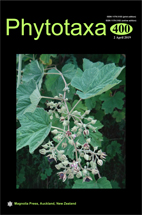Abstract
The genus Gymnosphaera was originally established by Blume (1828) for two tree ferns from Java, Indonesia with naked sori and globular receptacles. It was emended by Copeland (1947) to contain tree ferns characterized by dark axes and exindusiate sori which were dorsal on simple veinlets. Holttum (1963) argued to adopt only one genus, Cyathea Smith (1793: 416), to contain all Malaysian species and proposed a subdivision of Cyathea into two subgenera, with each containing two sections. Gymnosphaera was treated as a section under C. subgen. Cyathea and was circumscribed as “stipe-scales flabelloid, sori indusiate, axes very dark, and fertile and sterile pinnules usually very dimorphous” (Holttum 1963). In modern classifications of Cyatheaceae, Gymnosphaera was considered as either a separate genus (e.g., Smith et al. 2006) or a synonym of Alsophila R. Brown (1810: 158) (e.g., PPG I 2016). Molecular data, however, strongly supported Gymnosphaera to be a distinct group from Alsophila (Korall et al. 2007, Korall & Pryer 2014, Dong & Zuo 2018). Considering the remarkable divergence from Alsophila in molecular phylogeny, morphology, and sporogenetic mechanism, Gymnosphaera was formally reinstated as a distinct genus (Dong & Zuo 2018). According to Dong & Zuo (2008), there are 43 taxa (39 species, one subspecies, and three varieties) currently known in Gymnosphaera.

